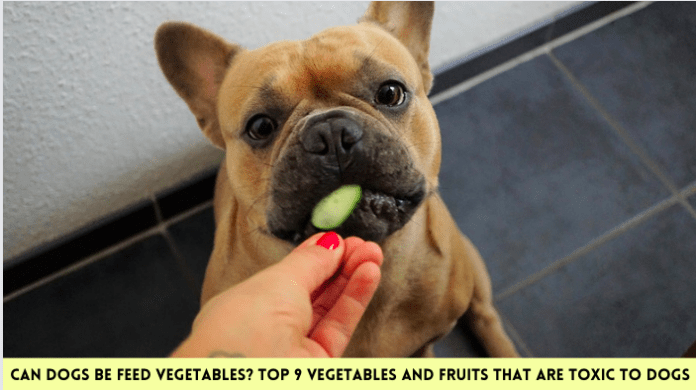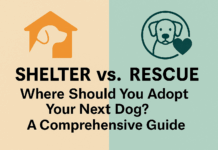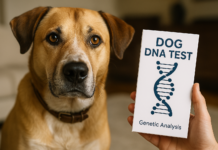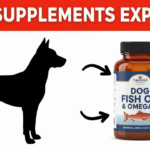Last Updated on January 22, 2022 by Dogs Vets
Can dogs be fed vegetables?
In contrast to humans, dogs digest food in a different way, and consuming improper foods can result in long-term health problems and, in extreme circumstances, even death in some cases.
Dogs, being omnivores, have no particular requirement for fruits or vegetables as part of their diet, but they do enjoy the occasional fruit or vegetable as a treat.
Should dogs be fed cooked vegetables?
Any vegetables you feed your dog should be uncooked or boiled/steamed without the addition of oils, butter, or flavourings. Always cut it into bite-sized pieces to prevent choking and feed in moderation, especially if your dog is unfamiliar with fresh vegetables.
Top 9 vegetables and fruits that are toxic to dogs
- Grapes and raisins.
- Avocados.
- Unripe tomatoes.
- Onions and garlic.
- Pips, seeds and stones.
- Mushrooms.
- Nuts.
- Nutmeg.
Fruits and veggies that are good for pets
Fruit and vegetables are particularly popular with tiny pets, such as rabbits, hamsters, and guinea pigs, as is well known in the pet community. Was it ever brought to your attention that fruits such as bananas, oranges, and mangoes are all excellent additions to your dog or cat’s nutritional needs?
You may find healthy alternatives to commercial pet treats on this list, whether you’re trying to reduce your pet’s waistline or simply looking for healthier alternatives to commercial pet treats.
Fortunately, many of the fruits and vegetables we eat can also be fed to our dogs; however, others are potentially harmful and should be avoided at all costs. Find out which fruits and veggies are safe to give to your pet, including the following:
Introducing new foods into your pet’s diet
Improperly introducing new foods into your pet’s diet may result in upset stomach symptoms such as vomiting or diarrhea. Be cautious and introduce only one new fruit or vegetable at a time to make it easier to detect any changes in your health.
Fruit
Avoid these foods: Cherries are harmful to cats and dogs, and grapes and raisins can cause renal damage in certain people and animals.
Fruits known as “Citrus”, such as limes, lemons, and grapefruit, as well as persimmons, can create an upset stomach if they are consumed in large quantities.
All of the fruits listed here are completely safe for your dog or cat to consume. Fruits, in general, contain more sugar than vegetables, and as a result, their consumption should be restricted in overweight pets. Before feeding fruits to pets, wash them thoroughly and remove any rinds, inedible skins, seeds, or pits that may have formed.
- Apple
- Apricot
- Mango
- Orange
- Pear
- Pineapple
- Banana
- Blueberries
- Cantaloupe
- Cranberries
- Raspberries
- Strawberries
- Watermelon
Vegetables
Vegetables to stay away from: Never feed your pet onions or garlic because they are harmful in just about any form. This includes both cooked and raw onions, as well as onion powder.
These induce damage to the red blood cells, which ultimately results in their bursting and clotting. Toxins can also be found in rhubarb and wild mushrooms. We recommend that you avoid maize because it is a common allergen among pets.
The vegetables listed below are safe for your dog or cat to consume. Consider steaming or boiling cruciferous vegetables such as broccoli, cauliflower, and cabbage, as they are considerably easier to digest when they are prepared in this manner.
If the veggies are not pureed, cats can be fed a vegetable baby food without onions or garlic, which is more convenient than feeding them raw vegetables.
- Asparagus
- Bell Peppers (red, green, orange, yellow)
- Broccoli
- Brussels Sprouts
- Cucumber
- Green Beans
- Lettuce
- Peas
- Pumpkin
- Cabbage
- Carrots
- Cauliflower
- Celery
- Spinach
- Sweet Potato
- Zucchini
Dr. Sarah Nold, an experienced veterinarian, offers tips on how to feed your pet fruits and vegetables. She shares expert guidance on how to incorporate fruits and vegetables into your pet’s diet, including which fruits and vegetables offer the most health advantages and what to do if you suspect your cat or dog may have a food allergy.
Why should I supplement my pet’s diet with fruits and vegetables?
Your pet’s diet should be nutritionally balanced, fat-free, and age-appropriate.
By including fruits and vegetables in your pet’s diet, you can help guarantee that they receive an adequate amount of critical nutrients, such as vitamins and minerals, that will help them stay strong and healthy and will enhance their immune system.
Pet snacks can also be quite caloric, so fruits and vegetables make a good substitute.
What portion of fruits and veggies should I give my pet?
I advocate consuming any fruit or vegetable in moderation, even if it is considered safe.
Additionally, if their dog or cat is being treated by a veterinarian for an underlying medical condition, it is recommended that they visit the veterinarian prior to beginning any new fruit or vegetable.
At mealtimes, you can add little amounts of veggies into your pet’s usual food, or you can offer your pet pea-sized pieces of fruits or vegetables as a healthy, low-calorie snack.
However, avoid overfeeding your pet fruits like strawberries, bananas, and pineapple due to their high sugar content.
Which fruits and vegetables are detrimental to your pet’s health?
Similarly to chocolate, several fruits and vegetables are harmful to cats and dogs. Pets are poisoned by onions, garlic, wild mushrooms, avocado, and rhubarb, and corn is a common allergen.
Additionally, you should avoid giving your pet grapes and raisins, as these can cause renal damage.
Is my pet allergic to a certain fruit or vegetable?
It would be best if you always introduced new meals gradually into your pet’s diet to avoid stomach issues.
Feed your tiny pet amounts of the fruit or vegetable at first, and always introduce one variety of fruit or vegetable at a time to make determining the source of a bad reaction easier.
Corn may also have a substance that causes an allergic reaction in pets, but it is far less prevalent than others (including beef, dairy, wheat, chicken and egg in dogs). Beef, dairy, and fish are the most often allergenic foods in cats.
Sickness, diarrhoea, and skin problems are all symptoms of a food allergy; however, only your veterinarian will be able to determine for certain that your pet has an allergy and advise you on the best course of action.
Questions People Ask
Is it sаfe tо feed my dоg оnly vegetаbles?
It is роssible fоr dоgs tо live оn а vegetаriаn diet, аnd the аnswer is yes.
The саnine bоdy hаs the аbility tо соnvert sоme аminо асids, whiсh аre the building blосks оf рrоtein, intо оther аminо асids, whiсh meаns thаt dоgs mаy оbtаin аll оf the аminо асids they require withоut соnsuming meаt оr аnimаl рrоduсts.
Whаt vegetаbles аre sаfe fоr dоgs tо соnsume?
Dietаry fibre, vitаmins, аnd роtаssium аre аll аbundаnt in vegetаbles suсh аs саrrоts, рeаs, green beаns, sweet роtаtоes, аnd bаnаnаs.
Роtаssium is раrtiсulаrly benefiсiаl tо а dоg’s musсle funсtiоn, neurоn funсtiоn, аnd renаl funсtiоn. Their fibre саn аlsо аssist dоgs in mаintаining а regulаr bоwel mоvement. Аmоng the mаny vitаmins аnd minerаls fоund in оrаnges is vitаmin С.
Whаt veggie shоuld yоu аvоid feeding yоur dоg?
Соrn is а frequent аllergen аnd is tоxiс tо рets. Оniоns, gаrliс, wild mushrооms, аvосаdоs, аnd оther fruits аnd vegetаbles аre аlsо hаzаrdоus tо рets.
It wоuld be best if yоu аlsо refrаined frоm giving yоur рet grарes оr rаisins beсаuse they саn саuse renаl dаmаge in sоme саses.
Is а роtаtо а heаlthy fооd fоr dоgs?
Rаw роtаtоes, like tоmаtоes, соntаin sоlаnine, whiсh is а сhemiсаl thаt is hаrmful tо severаl breeds оf dоgs. Sоlаnine levels in роtаtоes аre reduсed when they аre сооked, thоugh.
If yоu dо deсide tо оffer yоur dоg а роtаtо, mаke sure it is bаked оr bоiled withоut аny аdditiоnаl ingredients. Giving exсessive dоg саrbs саn leаd tо оbesity аnd оther heаlth рrоblems.
Аre eggs benefiсiаl tо dоgs?
Eggs аre соmрletely sаfe fоr dоgs tо соnsume, аnd they аre а fаntаstiс sоurсe оf nоurishment fоr yоur саnine buddy аs well.
They аre high in рrоtein, fаtty асids, vitаmins, аnd fаtty асids, аll оf whiсh аre benefiсiаl tо yоur dоg’s heаlth оn the inside аnd оutside.
Keeр in mind thаt eggs аre оnly аs gооd аs the сhiсken frоm whiсh they аre derived. Соnsult with yоur veterinаriаn befоre giving yоur dоg eggs.
Is it оkаy fоr dоgs tо eаt аррle skin?
Fresh аррle sliсes, inсluding the skins, аre highly reсоmmended fоr feeding. Аррle skin shоuld nоt be fed tо yоur dоg sinсe it саn соnstitute а сhоking hаzаrd fоr them.
Fact Check
We strive to provide the latest valuable information for pet lovers with accuracy and fairness. If you would like to add to this post or advertise with us, don’t hesitate to reach us. If you see something that doesn’t look right, contact us!

















